Notes on CORTINARIUS in the Pacific Northwest
Prepared for the Pacific Northwest Key Council
By Ian Gibson, South Vancouver Island Mycological Society
Copyright © 2011 and 2017 Pacific Northwest Key Council
INTRODUCTION
Cortinarius fruitbodies have a cap with gills and a stipe. Most species have a cobweb-like partial veil called a cortina. They have ornamented spores giving a cinnamon brown to rusty brown spore print and mature gill color. Cortinarius species form ectomycorrhizas with a variety of woody hosts, especially Pinaceae, Fagales, and Salicaceae.
Cortinarius identification is difficult because of the large number of species, more than 2000 worldwide, some of them not yet formally described. Over 300 species have been documented for the Pacific Northwest and the number that actually occur here is much higher. There is no North American monograph, and mycologists have to use a wide range of references, some of them based on European species.
Identification is more likely if several ages of fruitbody are collected. Reactions should be recorded for KOH on the cap and cap flesh and iodine (Melzer’s reagent or Lugol’s solution) on the flesh of the stipe base.
A key by Daniel Stuntz was introduced by Pacific Northwest Key Council in 1981, but was more recently withdrawn as outdated. A comprehensive new key will not appear in the near future. In the meantime, descriptions are presented for a small number of the more easily recognized species.
Groupings of Cortinarius
The traditional divisions into subgenera have not held up under the assault of molecular research and Cortinarius is presently divided into loose "clades" whose members are genetically related to each other.
The term clade means a grouping of species that have a common ancestor (a monophyletic grouping). The word group is used here to indicate species with a similar appearance and carries no implication that the species are genetically related. Groups may include other groups.
M.M. Moser treated six subgenera in 1983 : Myxacium, Phlegmacium, Telamonia, Leprocybe, Seriocybe, and Cortinarius, with Dermocybe as a separate genus. Brandrud et al. (1990-98) only recognized five subgenera: Myxacium, Phlegmacium, Dermocybe, Telamonia, and Cortinarius. These traditional divisions still have some value in dividing the species by their external appearance. They are specified here as "groups" with simplified characters. There are species with intermediate characteristics that do not fall easily into one of these groups.
Myxacium group - both cap and stem slimy, e.g. C. mucosus, C. vanduzerensis, C. vibratilis
Phlegmacium group - cap viscid, stipe not viscid, e.g. C. occidentalis group, C. olympianus
(Bulbopodium group, included generally by Moser in Phlegmacium – at one time separate from Phlegmacium, cap viscid, stipe not viscid, prominent marginate bulb on stipe especially when young, e.g. C. olympianus)
Dermocybe group - neither cap nor stem viscid, mainly small, slender stemmed, brightly colored, conifer loving species with conical fibrous caps and yellow, olive, orange or red pigments, no universal veil, (has been treated in the past as its own genus), e.g. C. smithii, C. neosanguineus
Cortinarius violaceus group - dark blue-violet fruitbody, the group consisting of Cortinarius violaceus and C. hercynicus
Sericeocybe group - neither cap nor stem viscid, violet to pale violet or lilac-white colors, caps often silky or shaggy, e.g. C. alboviolaceus, C. camphoratus, C. traganus
Leprocybe group - neither cap nor stem viscid, a diverse group with olive, yellow, yellow-brown, rusty orange or brown color, caps not smooth (cap cuticles with particular microscopic structure), e.g. C. clandestinus
Telamonia group - neither cap nor stem viscid, cap hygrophanous (watery looking when wet, opaque and lighter color with abrupt margin when dry), color typically in brown shades, e.g. C. acutus group
There are several tentative schemes for clades of genetically related Cortinarius species. The following, for instance, is the scheme of Garnica et al. (2005), with examples of species from the different clades. A number of the 262 species sampled do not fit into the scheme, and North American collections were not thoroughly sampled. Further molecular work will be required before clades stabilize.
- Caerulescentes
- Heterocliti – C. callisteus
- Phlegmacioides – C. balteatus
- Percomes – C. percomis
- Vulpini
- Phlegmacium
- Praestantes
- Arguti – C. argutus
- Myxacium – C. mucosus
- Rozites – C. caperatus
- Purpurascentes – C. purpurascens
- Scauri – C. scaurus
- Alluti – C. allutus
- Pseudotriumphantes
- Dermocybe – C. sanguineus
- Anomali – C. anomalus
- Amarescentes – C. infractus
- Calochroi – C. calochrous, C. aureofulvus, C. cedretorum
- Cortinarius – C. violaceus
- Delibuti – C. delibutus, C. salor
- Renidentes – C. renidens
- Obtusi -
- Telamonia – C. alboviolaceus, C. casimiri, C. duracinus, C. erythrinus, C. evernius, C. laniger
SPECIES DESCRIPTIONS
Cortinarius acutus group Fr. group
| CAP 0.3-2.5 cm across, conic at first, expanding with acute umbo; hygrophanous, yellowish brown to light reddish brown+, fibrillose from veil when young, silky when dry, margin translucent-striate. GILLS adnate, crowded to distant; yellowish brown; edge whitish and finely saw-toothed. STIPE 1.5-8 cm x 0.1-0.5 cm, equal; whitish to pale yellowish brown; dry, silky becoming bald, but no distinct veil patches. ODOR weak, iodine to radish. HABITAT coniferous forests. MICROSTRUCTURES spores 7-8 x 4-5 um, elliptic, verrucose. REMARKS There are several other species in the group which are not easy to distinguish: some have blunt umbos, some lack cap striation, and some have whitish or yellowish veil patches on stem. Galerina species are somewhat similar. | Cortinarius acutus group
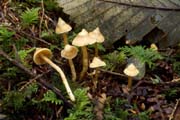
Steve Trudell |
Cortinarius alboviolaceus (Pers.) Fr.
| CAP 2-9 cm across, silvery violet-white or lilac-white when young, later ochraceous yellow to grayish white; dry, silky-fibrillose. GILLS adnate, adnexed, or notched, close; pale gray-brown, with a faint violet tinge when young, edge whitish. STIPE 5-12 cm x 0.5-1.0 cm, with base up to 2 cm wide; violet in upper part, with whitish silky fibrils overlying pale violet surface in lower part; dry, silky. ODOR mild. HABITAT in forest humus, associated mainly with hardwoods. MICROSTRUCTURES spores 8.5-10 x 6-6.5 um, elliptic to almond-shaped, verrucose. REMARKS Cortinarius camphoratus has strong raw potato – rotting vegetable odor; Cortinarius traganus has pear odor and flesh in stem is marbled brownish. | Cortinarius alboviolaceus

Ben Woo |
Cortinarius camphoratus (Fr.) Fr.
| CAP 3-10 cm across, pale bluish-lilac to almost white, then turning yellowish to yellowish brown from center; dry, with a silvery bloom at first, finely fibrillose; bluish violet when young (at least in upper part), then dark ochraceous yellow from base. GILLS crowded to subdistant, bluish violet when young, soon dark cinnamon brown. STIPE 4-10 cm x 1-2.5 cm, club-shaped to cylindric; pale bluish lilac, turning yellowish; dry, sheathed from base to ring zone with silky white fibrils. ODOR of raw potatoes or rotting vegetables. HABITAT under conifers and hardwoods. MICROSTRUCTURES spores 8.5-11.5 x 5-6.5 um, almond-shaped to elliptic, verrucose. REMARKS Cortinarius traganus has a fruity smell and lacks bluish colors in flesh and gills. | Cortinarius camphoratus

Michael Beug |
Cortinarius caperatus (Pers.: Fr.) Fr. (= Rozites caperata (Fr.) P. Karst.)
| CAP 5-15 cm across, light yellow-brown to beige-brown or orange-brown; dry, with a hoary sheen when young, usually wrinkled radially; flesh white. GILLS adnate to adnexed or notched, close; pale brown to darker brown with pale edges; often crisped or wavy. STIPE 5-13 cm x 1-2.5 cm, equal or slightly enlarged at base; white to pale tan or pale yellow-brown; top often striate or scurfy, fibrillose below the white membranous ring. ODOR mild. HABITAT on ground in woods. MICROSTRUCTURES spores 10.2-15 x 7-10 um, elliptic to almond-shaped, verrucose. | Cortinarius caperatus
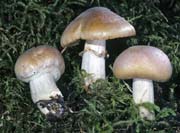
Michael Beug |
Cortinarius clandestinus group Kauffman group
| CAP 3-6 cm across, olive-brown to yellow-brown, with contrasting dark fibrillose scales especially in central part; dry; flesh yellowish olive to yellowish. GILLS adnate then sinuate, close, usually narrow; pallid to yellowish or olive-tinted. STIPE 4-10 cm x 0.5-2 cm, equal or slightly enlarged in lower part, typically yellow veil fibrils up to the obscure ring, or becoming bald. ODOR radish or mild. HABITAT under conifers. MICROSTRUCTURES spores 6-7 x 5-6 um, elliptic to nearly round, smooth. | Cortinarius clandestinus group

Michael Beug |
Cortinarius neosanguineus Ammirati, Liimat. & Niskanen
| CAP 1-5cm across, carmine red to blood red or deep red; dry, appressed fibrillose to minutely scaly; flesh red. GILLS adnate to adnexed or notched, close; blood red at first. STIPE 4-10 cm x 0.3-0.9 cm, equal or base slightly enlarged; colored as cap or slightly darker, base or lower third more ochraceous; dry, fibrillose. ODOR mild to radish. HABITAT mainly under conifers and often in beds of moss. MICROSTRUCTURES spores 6.5-9(10) x (3.5)4.5-5(5.5) microns, elliptic to ovate, verruculose. | Cortinarius neosanguineus
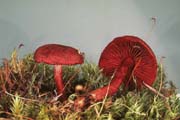
Ben Woo |
Cortinarius occidentalis A.H. Sm. group
| CAP 4-10 cm across, dull violet-gray with a vinaceous tint, to purple, lilac, or violet; slimy and somewhat streaked beneath slime, bald or nearly so; flesh cap-colored to pallid, when cut or bruised changing slowly to violaceous purple or pinkish magenta. GILLS adnexed or adnate, close; colored as cap when young, purplish or violet when bruised. STIPE 5-11 cm x 1-2 cm at top, with marginate bulb or club-shaped; colored as cap or a brighter lilac; dry, silky, fibrillose with the pallid veil remnants, staining purplish when handled. ODOR mild. HABITAT under conifers. MICROSTRUCTURES spores 7-9 x 4.5-5.0 um, elliptic, faintly tuberculate or wrinkled. REMARKS The description is for C. occidentalis (=C. mutabilis), one member of the purple-staining group which has at least these three other members. Cortinarius purpurascens has cap colors purple-brown to reddish brown or ocher-brown or darker brown, often variegated, and more sharply defined basal bulb on stem. In the Pacific Northwest it is most common along the coast, especially with Sitka spruce. According to Trudell and Ammirati, Cortinarius porphyropus is more slender than C. occidentalis (as C. mutabilis), the cap often pale grayish to brownish, without distinct lilac colors, and it has a narrow, club-shaped stem base. Cortinarius subpurpurascens has purple-staining gills but not flesh. C. cyanites stains reddish vinaceous but lacks the purplish red reaction (especially in stem base) to iodine of Cortinarius occidentalis. | Cortinarius occidentalis
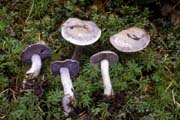
Steve Trudell |
Cortinarius olympianus A.H. Sm.
| CAP 3-7(10) cm across, pale violet or lilac, sometimes tinged yellowish at center; slimy or viscid when moist, smooth; flesh white to grayish. GILLS notched or adnexed to adnate, close to crowded; pale pinkish lilac in expanding buttons, brownish but strongly tinged lilac when mature, not staining when bruised. STIPE 3-7 cm x 0.7-1.2 cm at top, basal bulb has well defined rim, at least when young; lilac or pale violet in upper part, often brownish in lower part; dry. ODOR mild. HABITAT under conifers. MICROSTRUCTURES spores 8-10 x 5-6 um, elliptic, slightly roughened. REMARKS KOH applied to fresh cap or to flesh turns it instantly red (magenta). This differentiates it from other Cortinarius species with overall lilac to violet-white color, viscid cap, and dry stem with rimmed bulb. | Cortinarius olympianus

Steve Trudell |
Cortinarius smithii Ammirati, Niskanen & Liimat.
| CAP 3-8 cm across, dark red to rich red; dry, innately silky; flesh buff to light yellowish olive. GILLS adnate to adnexed or notched, close to distant; deep red. STIPE 4-11 cm x 0.6-1.5(3.0) cm, equal or sometimes club-shaped or thicker in middle; yellow to yellow-brown; dry, fibrillose. ODOR mild or slight radish. HABITAT under conifers or in mixed woods. MICROSTRUCTURES spores (6)6.5-8(9) x 4-5(5.5) um, elliptic, verruculose. REMARKS What has been called Cortinarius semisanguineus typically has a yellow-brown to olive-brown cap. Another reddish capped species is best distinguished by its fluorescence in 360-nm ultraviolet light: the lower stem glows a rich orange-yellow. | Cortinarius smithii
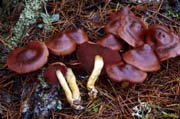
Steve Trudell |
Cortinarius traganus Fr.
| CAP 4-13 cm across, pale lilac to violet, often with white wedged sectors, sometimes with brown stains; dry, finely silky or fibrillose; flesh marbled, becoming yellowish to brownish, especially in stem base. GILLS adnexed to adnate, close; brownish yellow to gray-brown. STIPE 5-12 cm x 0.8-3(5) cm, club-shaped, pale lilac to purplish; dry, finely fibrillose, veil forming lilac to yellowish woolly girdle. ODOR like over-ripe pears, fruity. TASTE bitter to mild. HABITAT under conifers. MICROSTRUCTURES spores 8-10 x 5-6 um, elliptic to almond-shaped, verrucose. REMARKS Cortinarius alboviolaceus is paler with mild odor, has violet-edged gills when young, and never has rusty brown flesh. Cortinarius camphoratus has blue-violaceous flesh and gills, and odor of rotting vegetables. C. pyriodorus has pear odor but differs by having violet flesh. | Cortinarius traganus

Michael Beug |
Cortinarius vanduzerensis group A.H. Sm. & Trappe group
| CAP 4-10 cm across, dark chestnut brown becoming cinnamon brown; very slimy; wrinkled radially; flesh pale becoming orange-yellowish. GILLS adnate or adnexed, close, pale to buff-brown, rarely slightly lilac or gray-tinted. STIPE 8-20 cm x 1-2 cm, equal or narrowed slightly to the base, usually light violet to dark lavender in upper part, pale yellowish brown to whitish lower down; slimy, at times broken into concentric zones over lower third. ODOR mild. HABITAT under conifers. MICROSTRUCTURES spores 11-15 x 7-9 um, elliptic to ovate, warty-wrinkled. | Cortinarius vanduzerensis group

Michael Beug |
Cortinarius vibratilis group (Fr.) Fr. group
| CAP 1.5-5 cm across, slightly hygrophanous, orange-brown to brownish yellow, cap edge whitish; slimy; flesh whitish. GILLS adnate, notched, or slightly decurrent, close; whitish becoming dull yellow brown. STIPE 3-7 cm x 0.3-1.0 cm, club-shaped to equal; white, discoloring orangy in places; viscid or slimy when moist. ODOR mild. TASTE bitter: the bitterness of cap surface detectable by pressing tongue against it. HABITAT under conifers and under hardwoods. MICROSTRUCTURES spores 6-9 x 4-5 um, elliptic, weakly verrucose. REMARKS The description is for Cortinarius vibratilis group, but other similar species occur in the Pacific Northwest. | Cortinarius vibratilis group
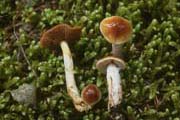
Ben Woo |
Cortinarius violaceus (L.) Gray
| CAP 3.5-12(15) cm across; deep violet to nearly black, often with a metallic shine; dry, densely covered with erect scales, giving it a coarse velvety appearance; flesh violet with white mottling. GILLS adnate becoming adnexed or notched, close to subdistant; violet, edges white-fringed. STIPE 6-18 cm x 1-2.5 cm thick at top, equal or more often thicker in lower part; violet; dry, fibrillose. ODOR mild, cedar, or leather. HABITAT under conifers. MICROSTRUCTURES spores 11-14 x 7-10 um in Europe, but Arora gives 13-17 x 7-10 um for California, elliptic to almond-shaped, verrucose; pleurocystidia and cheilocystidia more prominent than in most Cortinarius species. REMARKS Many other Pacific Northwest Cortinarius species are violet, but none with the deep color and dry plush cap surface. The violet color usually appears paler or bluer in photographs than in real life. | Cortinarius violaceus

Fay LeBlanc |
REFERENCES
- Ammirati, Joseph F., Smith, Alexander H. 1977. "Studies in the Genus Cortinarius, III: Section Dermocybe, New North American Species". Mycotaxon V(2): 381-397.
- Ammirati, Joseph F., Smith, Alexander H. 1978. "Studies in the Genus Cortinarius, IV: Section Dermocybe, New North American Species". Mycotaxon VII(2): 256-264.
- Ammirati, Joseph F., A.H. Smith. 1984. "Cortinarius II: A Preliminary Treatment of Species in the Subgenus Dermocybe, Section Sanguinei, in North America, North of Mexico". McIlvainea 6(2): 54-64.
- Ammirati, Joseph F., A.H. Smith. 1988. "Dermocybe, (or Cortinarius, Subgenus Dermocybe) Some Species in the Sections Dermocybe, Holoxanthae, and Malicoriae". McIlvainea 8(2): 49-64.
- Ammirati, Joseph F. 1988. "Dermocybe (Cortinariaceae, Agaricales): North American Names - New Combinations, Synonyms and Notes." Mycotaxon 33: 437-446.
- Ammirati, Joseph F. 1989. "Dermocybe Section Sanguineae in Northern California." Mycotaxon 34: 21-36.
- Brandrud, T.E., H. Lindstrom, H. Marklund, J. Melot, S. Muskos. 1990-94. Cortinarius Flora Photographica Volumes 1-3.
- Breitenbach, J., Kränzlin, F. 2000. Fungi of Switzerland Volume 5 Agarics Part 3. Cortinariaceae. Edition Mykologia Lucerne.
- Garnica, Sigisfredo, Michael Weiß, Bernard Oertel, and Franz Oberwinkler. 2005. "A framework for a phylogenetic classification in the genus Cortinarius (Basidiomycota, Agaricales) derived from morphological and molecular data." Can J. Bot. 83: 1457-1477.
- Høiland, K. 1984. "Cortinarius Section Dermocybe." Op. Bot. 71: 1-113.
- Kauffman, C.H. 1932. "Cortinarius". North American Flora 10: 282-348.
- Moser, M. 1983. "Die Röhrlinge and Blätterpilze". In Kleine Kryptogamenflora, Band II b/2. 5th ed. Edited by H. Gams. G. Fischer. Stuttgart.
- Moser, M.M., K.H. McKnight. 1987. "Fungi (Agaricales, Russulales) from the alpine zone of Yellowstone National Park and the Beartooth Mountains with special emphasis on Cortinarius". In Arctic and alpine mycology II. Edited by G.A. Laursen, J.F. Ammirati and S.A. Redhead. Plenum, New York. pp. 299-317.
- Moser, M.M., K.H. McKnight, M. Sigl. 1995." The genus Cortinarius (Agaricales) in the Greater Yellowstone area: mycorrhizal associations and taxonomic considerations". In Plants and their environments: Proceedings of the First Biennial Scientific Conference on the Greater Yellowstone Ecosystems. Sept. 16-17, 1991. Edited by D.G. Despain. Tech. Rep. NPS/NRYELL/NRTR-93/XX: 239-246.
- Smith, Alexander H. 1939. Studies in the Genus Cortinarius I. Contributions from the University of Michigan Herbarium No. 2. Ann Arbor. University of Michigan Press.
- Smith, Alexander H. 1944. "New and Interesting Cortinarii from North America". Lloydia 7(3): 163-235.
- END -

